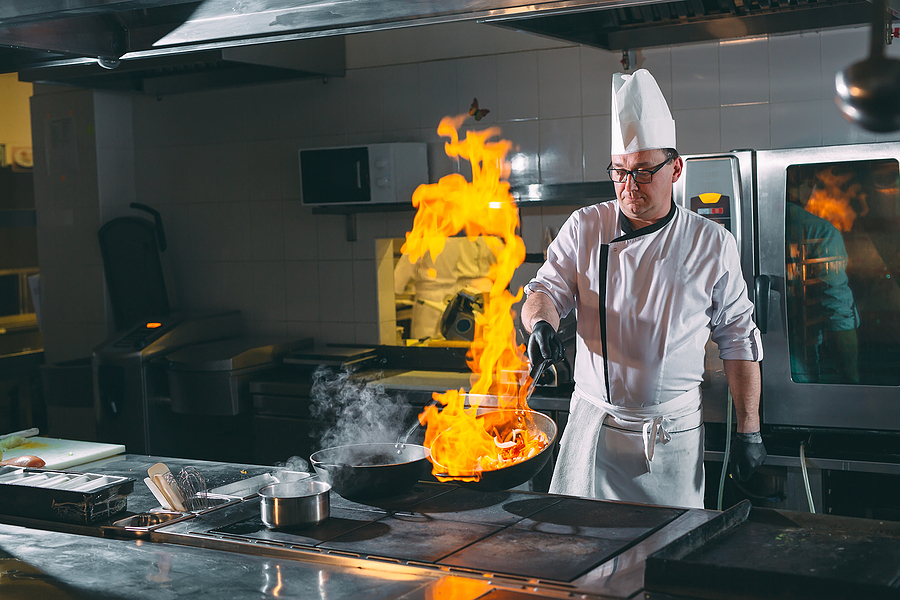There are about 7,500 commercial kitchen fires every year, with an associated $80M in property damage annually, reports the National Fire Protection Association (NFPA).
Many of the fires are started by cooking equipment, and some by faulty wiring or unattended open flames.
A fire at a restaurant can blow up into a catastrophe. Commercial kitchen fires can be particularly difficult to suppress and extinguish on account of kitchen staff working between and around the hot equipment on the line and other burning hot culinary products like grease.
Fires cause thousands of dollars in property damage and can close a restaurant for weeks, or even permanently, if they’re not caught early. The best way to put out a kitchen fire is to avoid having it happen in the first place.
Here are some commercial kitchen fire safety tips:
How to Prevent Kitchen Fires
Many commercial kitchens are equipped with the tools they need to put out a fire, but there are some things business owners can do if they want to prevent fires from starting at all. If you manage a kitchen, here are options for stopping a fire in its tracks:
Priority on Safety: Because safety is everyone’s job and responsibility, make certain to educate both your front-of-house and kitchen staff in what to watch for in spotting and preventing fire hazards, what to do in the event of a fire, and how to execute an evacuation plan in the event of fire. And when the whole team keeps it safe, fire risk is minimized.
Stay Tidy in the Kitchen: A good rule for home and commercial kitchens alike: keep your work area neat and tidy. Most fires in the kitchen happen when a flammable object (like a towel, or a food container) is accidentally set on fire due to an open flame. And finally, even when not in use, cooking oil, grease, and heating oil products should be kept away from cooking surfaces; doing so minimizing the risk of a large grease fire.
Check Your Equipment: Cooking equipment is the primary cause of kitchen fires, but the second leading cause is bad wiring. Inspect all wires and lines for fraying and splicing. If you see a product not working correctly, unplug it right away and contact the dealer for a repair or replacement. You should also ensure that your exhaust systems are functioning properly through routine inspection.
Install an Automatic Fire Suppression System: Adding an automatic fire suppression system is like having a firefighter on standby. The devices are designed to automatically release fire suppressive agents to douse fire and turn off fuel or electric feed to equipment. Systems must be sold and installed by a professional company or serviced regularly to function effectively.
Purchase a Class K Fire Extinguisher: You never know things will go south so it helps to have a Plan B. In restaurants, you should keep a class K fire extinguisher nearby and accessible to kitchen workers. Class K extinguishers are intended for cooking oil and grease fires only and should be used after the activation of a built-in hood suppression system. These are not the same as the Class ABC fire extinguishers for other types of fires.
Most Common Causes for Kitchen Fires
Fires in commercial kitchens are more likely to occur than the fires that happen in homes, given the volume of food prepared and equipment used. The following reasons for restaurant kitchen fires are common:
Cooking Oils and Grease Traps: Cooking oils and grease traps are the leading cause of kitchen fires. Overflowing or a blocked grease trap can very well ignite with an open flame.
Clogged Exhaust Hood Filters: Exhaust hoods work to remove excess smoke, grease, and gas. This could lead to flashing (i.e. ignition) of the grease accumulated in the filter if the hood filters are not cleaned regularly.
Gas Leaks: Gas leaks and the fires that follow may be the most catastrophic type of emergency at a restaurant, some would say. There isn’t just a danger of serious damage to property, but also potential risk to the life and welfare of restaurant employees.
Electrical Wiring: An electrical fire is sparked when bad wiring, a plug or socket sparks and emits heat or a flame on to a combustible surface. The NFPA says electricity creates 21% of restaurant fires.
Final Thoughts
Review each fire safety risk mentioned here and then do what is needed for each risk to eliminate or reduce your chances of a fire catastrophe in your restaurant. If you need help or guidance when it comes to assessing fire safety risk at your restaurant call Brazas Fire today at 505-889-8999!
